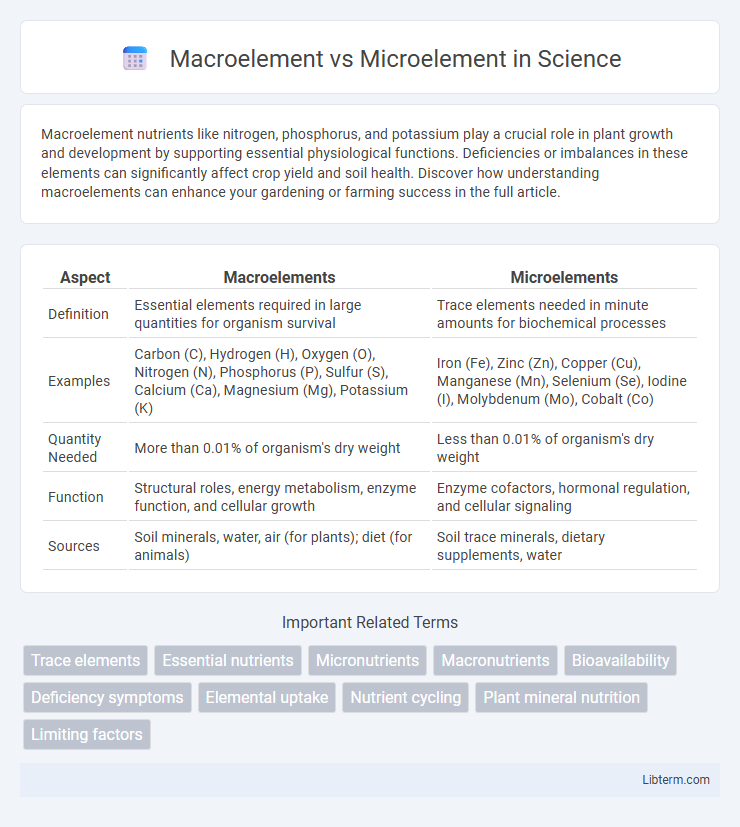Macroelement nutrients like nitrogen, phosphorus, and potassium play a crucial role in plant growth and development by supporting essential physiological functions. Deficiencies or imbalances in these elements can significantly affect crop yield and soil health. Discover how understanding macroelements can enhance your gardening or farming success in the full article.
Table of Comparison
| Aspect | Macroelements | Microelements |
|---|---|---|
| Definition | Essential elements required in large quantities for organism survival | Trace elements needed in minute amounts for biochemical processes |
| Examples | Carbon (C), Hydrogen (H), Oxygen (O), Nitrogen (N), Phosphorus (P), Sulfur (S), Calcium (Ca), Magnesium (Mg), Potassium (K) | Iron (Fe), Zinc (Zn), Copper (Cu), Manganese (Mn), Selenium (Se), Iodine (I), Molybdenum (Mo), Cobalt (Co) |
| Quantity Needed | More than 0.01% of organism's dry weight | Less than 0.01% of organism's dry weight |
| Function | Structural roles, energy metabolism, enzyme function, and cellular growth | Enzyme cofactors, hormonal regulation, and cellular signaling |
| Sources | Soil minerals, water, air (for plants); diet (for animals) | Soil trace minerals, dietary supplements, water |
Introduction to Macroelement and Microelement
Macroelement nutrients such as nitrogen, phosphorus, and potassium are essential for plant growth in large quantities, playing key roles in physiological and biochemical processes. In contrast, microelements like iron, zinc, and manganese are required in trace amounts but are crucial for enzymatic functions and maintaining plant health. Understanding the difference between macroelements and microelements helps optimize soil fertility and crop yield through balanced nutrient management.
Definition of Macroelement
Macrolements, also known as macronutrients, are essential elements required by plants and organisms in large quantities to support vital physiological functions such as growth, energy production, and cellular structure. Common macroelements include nitrogen (N), phosphorus (P), and potassium (K), which play critical roles in photosynthesis, nutrient transport, and enzyme activation. Unlike microelements, which are needed in trace amounts, macroelements are fundamental components of key biomolecules like nucleic acids, proteins, and carbohydrates.
Definition of Microelement
Microelements, also known as trace elements, are essential nutrients required by organisms in minute quantities for vital biochemical and physiological functions. These elements, including iron, zinc, copper, and manganese, play crucial roles in enzyme function, hormone production, and maintaining immune system health. Unlike macroelements, which are needed in larger amounts, microelements are indispensable despite their low concentration for optimal growth and development.
Essential Roles of Macroelements
Macroelements, such as nitrogen, phosphorus, potassium, calcium, magnesium, and sulfur, play essential roles in plant growth and development by contributing to structural components, enzyme activation, and energy transfer processes. These elements are required in larger quantities compared to microelements, supporting vital physiological functions like photosynthesis, cell division, and nutrient transport. Deficiencies of macroelements often result in significant growth retardation and reduced crop yield.
Essential Roles of Microelements
Microelements, also known as trace elements, play crucial roles in enzyme function, hormone production, and maintaining immune system health despite being required in minute quantities compared to macroelements like calcium and potassium. Key microelements such as iron, zinc, copper, manganese, and selenium act as cofactors for essential biochemical reactions and contribute to antioxidant defense mechanisms. Deficiencies in microelements can lead to severe health issues, including anemia, impaired growth, and weakened immune response, highlighting their indispensable role in human nutrition and metabolic processes.
Key Differences Between Macroelement and Microelement
Macroelements, such as nitrogen, phosphorus, and potassium, are essential nutrients required by plants in large quantities, whereas microelements like iron, zinc, and manganese are needed in trace amounts. The primary difference lies in their concentration levels and roles; macroelements mainly contribute to structural components and energy transfer, while microelements often function as enzyme cofactors and in metabolic regulation. Understanding these distinctions is vital for optimizing fertilizer formulations and ensuring balanced plant nutrition.
Sources of Macroelement in Diet
Macroelement nutrients, including calcium, potassium, magnesium, sodium, phosphorus, and sulfur, are predominantly sourced from foods such as dairy products, leafy green vegetables, nuts, seeds, whole grains, and meat. These elements are required in larger quantities for essential bodily functions like bone formation, muscle contraction, and nerve transmission. Diets rich in fresh fruits, vegetables, legumes, and animal-based products typically provide sufficient macroelements to meet daily nutritional needs.
Sources of Microelement in Diet
Microelements, also known as trace elements, are essential nutrients required in small amounts for vital physiological functions, including iron, zinc, copper, selenium, and iodine. Rich dietary sources of microelements include seafood, nuts, whole grains, legumes, leafy green vegetables, and organ meats, which provide bioavailable forms necessary for enzymatic activities and immune support. Deficiencies in microelements can lead to various health issues such as anemia, impaired cognitive function, and weakened immune response, highlighting the importance of a balanced intake from diverse food sources.
Deficiency Symptoms: Macroelement vs Microelement
Macroelement deficiency symptoms include stunted growth, chlorosis, and poor root development due to the lack of nitrogen, phosphorus, or potassium essential for vital physiological processes. Microelement deficiency symptoms manifest as leaf discoloration, necrotic spots, and deformed plant structures caused by insufficient iron, manganese, zinc, or copper, which serve as cofactors in enzymatic reactions. Timely identification of these symptoms allows for targeted nutrient management to restore plant health and optimize growth.
Conclusion: Importance of Balanced Element Intake
Balanced intake of macroelements such as nitrogen, phosphorus, and potassium alongside microelements like iron, zinc, and copper is crucial for optimal plant growth and human health. Deficiency or excess of either group can disrupt physiological processes, leading to poor development and increased susceptibility to diseases. Maintaining proper nutrient equilibrium ensures efficient metabolic functions and sustains overall ecosystem stability.
Macroelement Infographic

 libterm.com
libterm.com